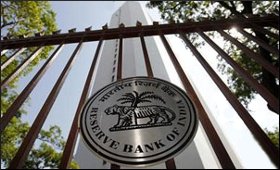|

|
RBI suggests policy reforms, expenditure cuts
|
|

|
|
| Top Stories |
 |
|
|
|
SME Times News Bureau | 24 Aug, 2012
The Reserve Bank of India said Thursday that lowering interest rates alone would not help put the economy on the growth track, and the government needs to make policy reforms and expenditure cuts, and address issues delaying infrastructure projects.
The Indian economy is unlikely to improve in the near term because of "policy stasis", the Reserve Bank of India said in its annual report 2011-12. New investments have slowed down substantially and existing investments' completion is getting delayed.
"Inflation is likely to remain sticky around 7 percent with upside risks emanating from a deficient monsoon," the RBI said.
It urged the government to reduce expenditure by cutting subsidies and called for "a step-up in capital expenditure to crowd-in private investment."
The report, which is released at the end of the central bank's accounting year, is a review of the previous fiscal year's macroeconomic conditions and outlook for the current year.
Investment in infrastructure has slumped 52 percent to Rs.1 trillion from Rs.2.2 trillion a year ago, with power and telecom accounting for most of the drop.
The fall in corporate investment in large projects "has had a ripple effect on the economy", the RBI said.
India's growth dived to a nine-year low of 5.3 percent in the March quarter, and economists have cut their 2012-13 forecast to around 5.5 percent, lower than the RBI's revised projection of 6.5 percent.
Inflation, which had stayed well above 7 percent for two and a half years, has eased, although food prices rose.
Despite the growth slowdown, "inflation control remains the cornerstone of monetary policy as upside risks to inflation remain", the annual report said.
The deficient monsoon has emerged as a new uncertainty in the growth equation and the RBI sees signs of suppressed inflation in diesel, electricity, coal and fertilizer prices that need to be adjusted upwards.
"Inflation prevailed above the threshold level at which the growth-inflation trade-off stops working and high inflation turns inimical to growth and growth sustainability," it said.
The current high-inflation phase is one of the longest since the mid 1990s, the annual report said. Between January 2010 and November 2011, average inflation remained at 9.6 percent.
In the absence of signs of global recovery, domestic policies have to be adjusted to boost demand and investment, the RBI said.
|
|
|
| |
|
|
|
|
|
|
|
|
|
|
|
|
|
|
| |
| Customs Exchange Rates |
| Currency |
Import |
Export |
US Dollar
|
66.20
|
64.50 |
UK Pound
|
87.50
|
84.65 |
Euro
|
78.25
|
75.65 |
| Japanese
Yen |
58.85 |
56.85 |
| As on 13 Aug, 2022 |
|
|
| Daily Poll |
 |
 |
| PM Modi's recent US visit to redefine India-US bilateral relations |
|
|
|
|
|
| Commented Stories |
 |
|
|
|
|
|
| |
|